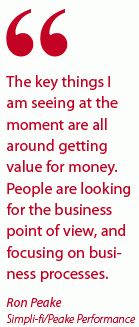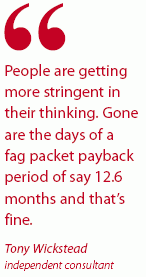Published on the 12/04/2010 | Written by Johanna Bennett

A good return on dollars spent on IT in these tough times should be a pre-requisite to investment – right? iStart asked those who know where to find it and got some surprising answers…
Perhaps the recession does have an upside. If you’re at all green, or concerned about your bottom line, you might be pleased to hear that organisations big and small are scrutinising their IT bottom line very closely indeed these days, to see just what sort of return on investment they’re getting from their technology. iStart asked five people in the field what their recent experience around IT investment has been. Long-time IT consultant Ron Peake, former CIO at NZMP (now Fonterra) and ENZA, says, “The key things I am seeing at the moment are all around getting value for money. People are looking for the business point of view, and focusing on business processes, and the business architecture to support these.” “It’s not only ROI; it’s the requirement to do more in-depth analysis. CIOs are having to understand the business case and what is the NPV (net present value), [or] the financial value of a project into the future. They’re having to discount the cashflow,” says Wickstead. Such detailed analysis is more usually the preserve of accountants and CEOs, and involves calculating cashflow using the ‘time value of money’, to arrive at the NPV, and so measure the financial viability of a project. “People are getting more stringent in their thinking. Gone are the days of a fag packet payback period of say 12.6 months and that’s Going mobile Peake says mobility solutions are becoming increasingly popular. “Organisations are asking: ‘how do we use these to our best advantage; how do we get our people mobile, and how do we get the knowledge out to them?’” They’re looking at different devices, so they can make business transactions and get data out into the field. The government in particular is interested, which came as a bit of a surprise given the usually slow moving pace of the public sector. As Peake says “They’re saying, ‘how do we free up our people and make them more mobile, and get them more customer-focused?’” Wickstead is also finding lots companies are looking at wireless technologies. The big interest is around mobile technologies’ ability to enhance productivity. The emphasis is on operational effectiveness, especially when it comes to equipping salespeople out in the field. Auckland-based mobile specialist Mobico is seeing something similar happen from the sales end. “The recession has sharpened some people’s thinking around cost and efficiency,” says Mobico solution specialist Allan Moyle. “A number of organisations have approached us in the last little while that are looking at how to be more efficient and productive. They realise they can’t continue doing things in the same old way.” Measurement and value There is the aforementioned accountants’ discounting of future cashflows, but that’s only part of it. Scorecards and business intelligence systems also play a part, but business improvement specialists the Kaizen Institute says, in practice, it’s not quite like that. Kaizen’s measurement methods derive from Japan and the Toyota car company, with its historic emphasis on continually fine-tuning production. Kaizen identifies and then measures the cost and effectiveness of organisations’ business processes. The aim is to help companies “do more with less”, something that has become increasingly important this past year or so, says chief executive Danie Vermeulen. “Last year, people needed to reduce spending, so they needed to work smarter, which is not to be confused with doing the same with less.” But it’s also about “continuous improvement,” says Vermeulen. “If you’re not improving, you will stagnate and go backwards.” Many people found themselves having to address needs further down the food chain than they were accustomed to, as a result of last year’s recession, but “continuous improvement” is connected with spending containment. If you address spending intelligently, you often end up with improved business processes. Vermeulen says he sees a lot of people working harder but not necessarily smarter, “because the processes they’re using are all over the place and aren’t efficient.” “You have to be careful when cutting spending and measure what you’re doing in case it’s not more efficient. For instance, cutting service levels can be risky. However, there is still a lot of slack in many systems. Waste is often as high as 70 percent.” (See box story below: Seven Sins of Waste.) But exactly how do you measure these processes, to discover what sort of ROI you’re getting on your IT – and it often is IT, as technology is increasingly used to address efficiency issues; but it’s not always used well. Take Microsoft Office and upgrading to Windows 7. “Why do you want to do that?” asks Vermeulen, referring to the fact that people often don’t use what they already have in an efficient or in a standard way. “You need to train people in the standards you want them to use. They shouldn’t have to re-invent the wheel every day. Sometimes this can come down to personal preference, but this can lead to people becoming inefficient very quickly.” As an example, Vermeulen points to how Microsoft Outlook’s many features are under-utilised, especially around email categorisation, despite this being potentially such a good efficiency tool. “You can map value by looking at the time taken to complete tasks, number of errors and how accurate completion is. We start at the bottom, at the practitioner level, and train these people to become self-sufficient. Then, at the next level, we train the coaches, so they can help people become proficient.” But before this, Kaizen’s “measurement” man Kimball Fink Jensen does the nitty-gritty analysis – with pictures. The bigger picture A lot of data we measure isn’t data as such, however, it’s visual indicators, or tools, says Jensen. For example, the fuel gauge on your car tells you when you’re running out of fuel. And there’s even a second dimension, with a light coming on, so you know when you’re below your safety level. “Having a lot of visual elements is good, as humans get most of their information visually – 83 percent of information is communicated visually.” On the visual measurement side, it’s about understanding what the problem might be. Perhaps an error in a despatch process? Unless people are recording this information, they can’t get to the cause of the problem, says Jensen. There are cultural challenges in installing measurement methods too, he says, as people can see measurement as punishment. “We need to help people to create their own measures to understand what is happening. These can be technical or tick marks that are later translated into a graph.” Jensen says he works with a lot of smaller companies, but some of these enjoy a sizable turnover. He mentions a company he’s currently working with that turns over $10 million but is having difficulty figuring out what’s happening in its business. “It has a good CRM/job management system, for capturing jobs that come in, but it doesn’t have the capability to measure the statistics associated with this, so it can’t see how the business is actually performing; what the problems are and what the opportunities are,” he says. “Unless you’re looking at the bigger picture, and seeing what the trends are, you have no context.” This isn’t, strictly speaking, a formal method of discovering the ROI on IT investment as in NPV, pay back periods etc, but it is a way of getting maximum practical value out of an organisation’s IT systems, whatever they are – and measuring that value too. Particularly when that measurement can be tracked before and after change. Jensen, for instance, is a big fan of Excel for smaller businesses. “Excel in the right hands can do an awful lot of analysis… [It] can analyse upcoming jobs and their product requirements, or job time, from notification to installation.” He makes the point that “IT is not a solution, it’s a tool. SAP or Oracle can’t tell you what to analyse. And the tool must fit the business. Many ERP systems come in modules that may not fit your business processes… They have a role in big business as they can customise. But you can grab data and analyse it in Excel. It can do some heavy duty analysis relatively easily.” Peake makes a related point about ERP. ““Bigger ERP systems are a thing of the past unless yours is a big organisation,” he says. Business ‘blueprints’ “[With] open standards, we’re starting to see a number of organisations looking at best-of-breed technologies. In particular, organisations are selectively out-sourcing and linking back through a backbone architecture. People are becoming a lot more selective with their technologies. One size may fit all for 80 percent [of your needs], but if they need 95 percent people are prepared to take the risk of making the integration work.” “[There has been a move away from] total outsourcing to one where people are looking at bringing certain pieces in-house and selectively outsourcing where necessary,” he says. “People are looking at business processes and knowledge from a management perspective. What they’re asking is: ‘what is the blueprint for our business? What is our point of difference? Do we need to invest in just information or product development, and, therefore, what are the commodity services we need to minimise spending on, so we can ensure we can pay for the other ones that we do need to invest money in?” Wickstead’s comments expanded on this point. “Projects that are showing a positive return, in terms of the business case, are going ahead, but companies are looking at different ways of delivering technology, rather than accepting the old vendor-client relationship. Email, for example, is a commodity service, and people are increasingly having it delivered as a service (SaaS). They’re also looking at other applications and asking: ‘should we keep this in-house?’” An example of this is the Post Office’s move last year to move to Google for email. Wickstead says Auckland Airport has been looking at a similar move. Clients are looking at vendors’ cloud offerings for commodity services like email, he says. But, they’re also looking at what other SaaS (Software as a Service) offerings are available. Source: 2010 iStart Investment Intentions Survey n=398 There has been a proliferation of cloud services and of cloud computing. For example, larger companies are now accessing ERP via the cloud, says Wickstead. Vendors such as JD Edwards and Oracle (which are now the same company) have been offering this overseas for some time now, he says. “We’re a little bit behind, but business down here is starting to access these integral services via the cloud; it’s coming to terms with this.” The reason behind this move is to cut back on staff costs. “You don’t need to employ so many people at the datacentre,” says Wickstead. Seven Sins of Waste This slack is largely composed of the following, says Vermeulen: 1. WAITING. A prominent example of this is waiting for sign-off approval, which can take an interminable time. Kaizen advocates a simple email sign-off. Then there is waiting for replies to emails, which are needed before work can progress. Kaizen recommends setting in place times for how long replies should take (an hour, a day) to overcome this. 2. OVER-PROCESSING. This is the tendency to make things too complicated, and includes those long email distribution lists people are flooded with. Typically, only two percent of emails are of use to people, says Kaizen. Similarly with meetings – there are too many of them and they waste time. 3. TRANSPORTATION WASTE. A stunning example of this, from a client, was the movement of printer paper through a variety of storage rooms, says Kaizen. 4. INVENTORY WASTE. Related to the above, this is often the “fat in the cupboards” syndrome. For example, a bank Kaizen worked with had huge numbers of toner cartridges stored in various cupboards. 5. ERROR WASTE. People make errors, which leads to inaccurate data that eventually, no-one feels they can trust. A big culprit here is Excel, says Kaizen. The result is people end up not trusting their organisation’s main system data, so they run systems on the side. Unfortunately, this means there’s “no one version of the truth”. The solution to this is discipline and training, says Kaizen. 6. OVER PRODUCTION. An example of this is producing and publishing reports that no-one wants to read, as they’re not really of use. This consumes resources unnecessarily. 7. HUMAN POTENTIAL WASTE. Perhaps the biggest waste: people doing work in a rote way – “functional thinking”. People may know a better way to do something, but won’t do so if they can’t see the beginning and end of a process, says Kaizen. They feel alienated. The solution is to engage staff more. … His view is strongly supported by Tony Wickstead, recently Auckland International Airport CIO. Wickstead says companies are going beyond just applying pressure to justify IT spending; they’re also looking for analysis.
His view is strongly supported by Tony Wickstead, recently Auckland International Airport CIO. Wickstead says companies are going beyond just applying pressure to justify IT spending; they’re also looking for analysis. fine. What’s happening is a demand for indepth analysis to make sure the business case stands up.”
fine. What’s happening is a demand for indepth analysis to make sure the business case stands up.”
One of the trends emerging in the wake of this new pressure to justify IT expenditure fully is a big interest in mobile solutions.
This new, sharpened interest in scrutinising the ROI on technology investments leads to the question: how do you measure it?
It goes back to Henry Ford, he says. “You have to speak with data if you’re ever going to improve. If you can’t measure what you’re looking at, how do you know what to do to improve? A gut feel is not enough.”
Peake says he is seeing a move to open standards and more selectivity in IT buying.

Kaizen’s CEO, Danie Vermeulen, believes that getting a good return on investment in technology has got a lot to do with how you use it – and ensuring that your company’s business processes aren’t contributing to that 70 percent slack in the system Kaizen has identified.
































